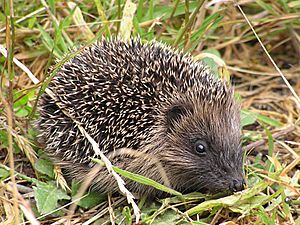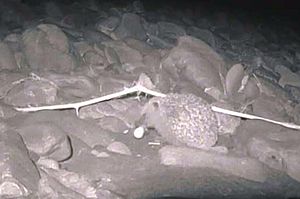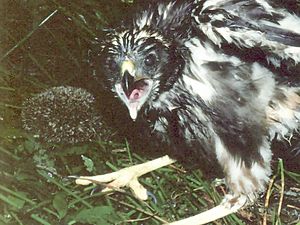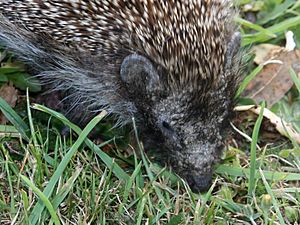Hedgehogs in New Zealand facts for kids

European hedgehogs were first brought to New Zealand by European settlers in the 1870s. They wanted a reminder of their home country. These hedgehogs have now spread almost everywhere in New Zealand. They are only missing from places that are too harsh to live in. Many people like hedgehogs, seeing them as harmless. However, conservation groups and local councils see them as pests. This is because hedgehogs hunt native animals and compete with them for food.
Contents
How Hedgehogs Arrived in New Zealand
Discussions about bringing hedgehogs to New Zealand started as early as 1868. The first European hedgehogs (Erinaceus europaeus occidentalis) were brought in by a group called the Canterbury Acclimatisation Society in 1870. More hedgehogs arrived in 1871, 1885, 1890, and 1894. Most likely, all these hedgehogs came from Britain.
Besides being brought for sentimental reasons, hedgehogs were also introduced to help control garden pests. They were meant to eat slugs, snails, and grass grubs.
Hedgehog Population Growth
Throughout the 1900s, many hedgehogs born in New Zealand were released into new areas. From just a few animals, their numbers grew very quickly. By the 1920s, there were so many hedgehogs that people blamed them for a drop in small game birds. A reward was even offered for catching them.
By the 1950s, hedgehog numbers were at their highest. It was estimated that there were 50 times more hedgehogs in New Zealand than anywhere else. Since then, their numbers have gone down. But in many parts of New Zealand, there are still more hedgehogs than in Britain.
By 1972, hedgehogs had probably spread as far as they could. Today, you can find hedgehogs in almost all types of places. This includes cities, farms, riverbeds, and forests. The only places they don't live are very tough environments. These include areas above the permanent snow line and the wettest parts of Fiordland.
Hedgehog Life in New Zealand
Since arriving in New Zealand, hedgehogs have become a bit smaller. They don't grow as big or heavy as hedgehogs in Britain and Europe. This is because European hedgehogs need to be larger to survive a six-month-long hibernation. In central and southern New Zealand, hedgehogs hibernate for about three months. However, in the warmer northern parts of the country, very few hedgehogs hibernate at all.
Who Hunts Hedgehogs?
Wild pigs, dogs, and cats are some animals that hunt hedgehogs. The native, flightless weka and the Pukeko will also eat young hedgehogs in their nests. The Australasian harrier hawk often eats hedgehogs that have been killed on roads. However, it's not known if these hawks actively hunt live hedgehogs.
Hedgehogs and People
Many people have a soft spot for hedgehogs. They see them as helpful animals that eat garden pests. Some people even try to rescue injured hedgehogs.
However, after studying hedgehogs, the Department of Conservation (DOC) and local councils now understand the harm they cause. They are now actively working to control hedgehog populations.
Threat to Native Animals

Hedgehogs hunt many of New Zealand's unique native animals. They prey on endangered giant snails (Powelliphanta) and native wētā species. They also eat many other native insects and invertebrates. The critically endangered Cromwell chafer beetle (Prodontria lewisi) is especially threatened by hedgehogs and other introduced animals.
Hedgehogs also eat the eggs and chicks of birds that nest on the ground. They may have already played a part in the decline or extinction of up to fifteen bird species. They continue to be a threat to the birds that are left. Hedgehogs are also another danger to endangered native skinks.
Because of this, hedgehogs are humanely controlled in many parts of New Zealand. DOC advises people not to encourage hedgehogs into their backyards. This means not creating burrows for them or leaving out milk. They suggest setting suitable traps, which are designed to kill the hedgehogs humanely.
Hedgehog Health Issues
In Europe, hedgehogs carry many hedgehog fleas (Archaeopsylla erinacei). But it seems that none of these fleas survived the long journey to New Zealand in the 1800s. So, New Zealand hedgehogs are free of fleas.
However, they do suffer from another tiny parasite called mange mites (Caparinia tripilis). These mites are found in the environment and can affect other animals, not just hedgehogs. The mites lay their eggs in the hedgehog's skin. When the eggs hatch, they cause many health problems for the hedgehog. These mites can blind and kill many hedgehogs. They likely played a big role in reducing hedgehog numbers in New Zealand. These are the same mites that can be carried by pet cats and dogs.




